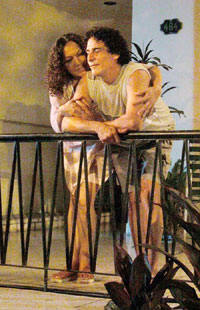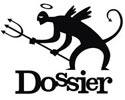A revealed face
By: Paquita Armas Fonseca
May 03, 2006
Cubarte translation from
http://www.lajiribilla.cu/2006/n260_04/260_13.html
 Havana,
(La Jiribilla).- In places as distant as Pamplona and Buenos Aires the
Cuban television series La cara oculta de la luna
(The hidden face of the moon) has been reflected on their newspapers or
web sites. It was also done in La Jornada, from Mexico, the
journal of the newspaper Periodista digital (Digital
journalist) or the Carla Antonelli Web, a transsexual information
portal. These are just a few examples of what you may find when you surf
the Internet.
Havana,
(La Jiribilla).- In places as distant as Pamplona and Buenos Aires the
Cuban television series La cara oculta de la luna
(The hidden face of the moon) has been reflected on their newspapers or
web sites. It was also done in La Jornada, from Mexico, the
journal of the newspaper Periodista digital (Digital
journalist) or the Carla Antonelli Web, a transsexual information
portal. These are just a few examples of what you may find when you surf
the Internet.There are comments in some libelous articles that are constantly dedicated to denigrating the Cuban Revolution, including of course the wrongly named Radio Marti.
Most of them have echoed press reports from the news agencies EFE, AFP or IPS, who in are in turn projecting the controversy unleashed in the greatest of the Caribbean Islands, its projection on the written press and on television itself.
This unusual highlight of a television program can be explained for only one reason: it is not common in Cuba, NOR IN OTHER COUNTRIES, for AIDS to be the thread of drama series, which are usually led by melodrama.
The television series, made up of five stories, tries to call attention to the pandemic, still without any solution, that is storming the planet since the 20th Century. Despite the fact that it is true that Cuba has the lowest rate of HIV incidence in Latin America, with a 0.07% of the population between 15 and 24 years, this is a matter that can not be left to one side because only by practicing a responsible sexuality can you talk about safe sex.
Natividad Guerrero, director of the Centro de Estudios de la Juventud (Youth Study Center), as she analyzed a research carried out with 2253 persons between 15 and 29 years, who lived in different areas, stated that “adolescents are still beginning their sexual relations without the necessary preparation. Their information sources are not always trustful and mistaken conceptions are still revealed on the topic”.
More than 50% of that population has an active sexual life without using a condom, because they lack the necessary perception of the risk with respect to sexual infections, including AIDS.
Precisely on those data on the topic, which can be found in abundance on the Cuban research centers, got immersed Freddy Domínguez, the scriptwriter of La cara oculta (The hidden face). “A topic such as HIV/AIDS- he says –calls for a lot of responsibility and various and deep investigations, that is why when I faced the novel, I didn’t just consult specialists from institutions such as CENESEX, the National Center and also the Territorial de Lucha (Local Fighting) against the ITS/HIV/ AIDS, but I also needed to held open and wide exchanges with people who are living with HIV, as well as with young people, adolescents, women and men from different ages who engage in risky sexual conduct, in most cases in an irresponsible way. That is why I can assure you that there is a lot of truth in the series, but never as much as in everyday life because we barely recreate reality, we put make-up on it and we make it a little more beautiful so that it can pass on the messages we trying to transmit”.
The first story dealt with adolescents and there the controversy began. The young Amanda, seduced and seductive, came into people’s homes telling grandparents, parents, mothers, aunts and uncles that girls (and boys) from secondary education, even those who are well-behaved and get excellent academic grades, are not so innocent anymore and what they need most is to be able to talk about any topic with adults. That so-called Amanda was not understood by some fathers and mothers who accused television of inciting their daughters to have sexual relations.
The Newspaper Juventud Rebelde has echoed dozens of opinions from all over the country, in which those who asked for the television producer’s blood and those who defended La cara (The face) as a good educational proposal for young people appeared in a good argument. At the end of it, everyone felt sorry for Amanda, infected with HIV with everything implied by that.
While still having not recovered the public completely from that story, it entered the story of Yassel, a young and manly construction worker who, being bisexual without knowing it, as he lets himself be attracted by Mario, an acknowledged homosexual, loses Belkis, the woman he loves and the mother of his daughter. Yassel ends up being infected with AIDS, as logic indicates in a television series directed to warning about that disease. And it is worth stopping here. With the sexual revolution of the sixties, a road started which lasts until today, towards the acceptance of homosexuals as people who enjoy sex with people of the same sex. Since the seventies, people don’t talk about that human group as being ill and on the level of the common citizen, if they are not accepted, they are at least tolerated. That is not the attitude towards bisexuals. Those men or women who have sex with one or another gender are ambiguous and are therefore questionable for a big part of society.
Nonetheless, Celestino Vasallo Mantilla, Doctor in Medical Sciences, Permanent Consulting Professor of Psychiatry, explains: “The percentage of bisexuals is greater than that of homosexuals in the world. As researches show, homosexuals oscillate between a four and a seven percent of the population, although there might be more in certain societies. Bisexuals reach about an 11 and a 15 per cent – there are people who say a 20 per cent- and heterosexuals are between a 75 and an 80 per cent. The important thing is to prevent HIV/ AIDS, which does not mean to forbid relations, but for the man and woman to protect themselves, and for them to be more selective.
If you add to this reality the fact that
close to the 90 percent of the HIV positives in Cuba are men who have
had sexual relations with other men, you can understand why was it
indispensable to tackle this in La cara (The face) and to
conceive it from male bisexuality and homosexuality, with common
characters, those who can be the closest neighbor. By doing it, if it
wasn’t Pandora’s Box, the one that was opened, it was a box full of
prejudices.
Together with expressions of repulsion towards Yassel and Mario (more of
them towards the first one than towards the second one), people want to
know how is this story that has unleashed thousands of anecdotes going
to end. In cafés, work places and buses most of the people, with that
kind of morbidity brought around by what is forbidden, supposedly knows
a bisexual who might be a good father, a good son, but “has that
problem”.
The reaction of a sector of the public in Cuba is not rare. If a man has
extramarital relations with a woman, no one is surprised, no one even
judges him, there are many who applaud him, but if it is with another
man, he has broken the schema imposed by western society since the
Middle Ages. It's a rule that has got to do with economic and religious
factors, exponents of a monogamous heterosexual family which guarantees
the conservation of the wealth on the already mostly filled-up chests.
The last edition of the Oscar Awards was an example of the prudishness
of the Academy in sex matters: if Brokeback Mountain
got the greatest number of nominations, it was not the best movie, how
to you depict the love between two cowboys, symbols of the American
macho man? In Spain, where marriage between homosexuals was legally
accepted recently, these groups and those of the bisexuals are still
being discriminated against at the work place and socially, the same as
in Great Britain and in other countries which proclaim a supposed
equality between every citizen no matter their sexual orientation.
Because the gay factor, to call it some way, is not accepted because it
is different from the majority of the population in cultures marked by
Christianity.
If the series has brought out controversies and wrong interpretations,
it has also contributed to having many more people at risk being aware
of HIV. There has been an increase in the number of people interested in
sexology appointments and even many pharmacies declare that there has
been an increase in their sales of condoms.
The truth is that Cuban television took a risk on the topic and it has
been successful because it has made AIDS into an everyday topic of
conversation, thereby helping people see sex with a greater sense of
responsibility. There are still three stories to go in La Cara
(The face), in which heterosexual infidelity, being social marginality
and alcoholism will be the driving force towards AIDS.
I hope that each and every one of those topics will be able to keep
attracting viewers so that safer sex can find its way and in such a way
HIV may be cornered. To protect oneself is, while there is no cure, even
if a cure were to appear, the only way to win the battle of AIDS, as it
is demonstrated by taking out of La cara oculta de la luna (The
hidden face of the moon) a revealed face.
Translation: Karen López (Cubarte)

 En
lugares tan distantes como Pamplona y Buenos Aires la teleserie cubana
La cara oculta de la luna ha sido reflejada en sus periódicos o
páginas digitales. También lo hizo La jornada, de México, el
periódico de periódicos Periodista digital o la Web Carla
Antonelli, portal de información transexual. Son solo algunos
ejemplos de los múltiples que una encuentra cuando navega en Internet.
En
lugares tan distantes como Pamplona y Buenos Aires la teleserie cubana
La cara oculta de la luna ha sido reflejada en sus periódicos o
páginas digitales. También lo hizo La jornada, de México, el
periódico de periódicos Periodista digital o la Web Carla
Antonelli, portal de información transexual. Son solo algunos
ejemplos de los múltiples que una encuentra cuando navega en Internet.